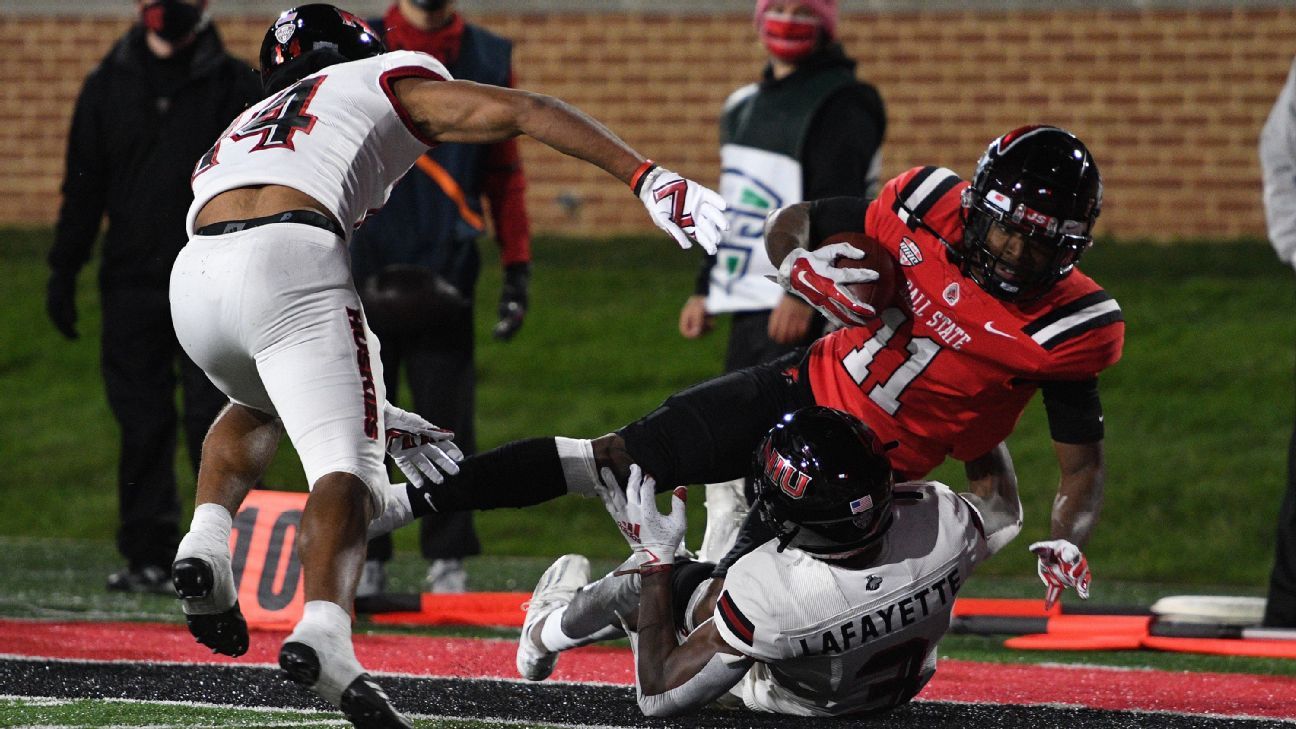The MAC West did its best to pack a full season’s worth of MACtion and tight finishes into an abbreviated half-season. Five of Ball State’s six regular-season games were decided by one score, and CMU, WMU and EMU each played four such games.
BSU won four of its five close games and earned a division title — and an opportunity to upset Buffalo in the MAC championship, deservedly so. But with most of the division’s best players coming back, we could see a repeat in the drama department. And what more could we ask for in life?
Every week through the summer, Bill Connelly will preview another division from the Group of 5 and Power 5 exclusively for ESPN+, ultimately including all 130 FBS teams. The previews will include 2020 breakdowns, 2021 previews and a brief history of each team in one handy chart. The series has thus far covered the Conference USA East and West, as well as the MAC East.
Jump to a team: Northern Illinois | Eastern Michigan | Western Michigan | Central Michigan | Toledo | Ball State

Though competitive at times, NIU went 0-6 in the abbreviated 2020 season. After nine winning seasons in 10 years, the Huskies have started just 5-13 under Thomas Hammock.
2021 Projections
Projected SP+ rank: 112th
Projected record: 4-8 (3-5)
-
Likely wins*: BGSU (71% win probability)
-
Relative toss-ups: EMU (50%), at Kent State (43%)
-
Likely losses: WMU (32%), Wyoming (30%), Ball State (27%), at Toledo (21%), at CMU (21%), at Buffalo (21%), at Georgia Tech (10%), at Michigan (3%)
* Likely wins are games in which SP+ projects the scoring margin to be greater than seven points, or above about 65% win probability. Likely losses are the opposite, and relative toss-ups are the games in between.
What we learned about NIU in 2020
There was no magic recovery. NIU began to leak oil late in the Rod Carey era, then officially reached “starting over” mode in Hammock’s first year in charge. After winning seven division titles in nine years, the Huskies were lucky to go even 5-7 in 2019 while ranking 115th in SP+.
A head coach’s second year may be his most fruitful from a culture-building standpoint — they signed their first full-cycle recruiting class, the players know what’s expected of them, etc. But Hammock’s second season was awash in Zoom meetings and uncertain schedules, and the 2020 NIU team was, on paper, almost identical to 2019.
What we didn’t learn about NIU in 2020
Is there enough raw talent for a turnaround? Hammock signed a solid recruiting class in 2021, and some of last year’s most intriguing players — linebacker Lance Deveaux Jr., defensive end Pierce Oppong, guard Logan Zschernitz, safety Jordan Hansen — were youngsters. In fact, most of the defensive line and secondary, and much of the skill corps as well, consisted primarily of freshmen and sophomores.
But the Huskies ranked 90th in offensive success rate and 102nd on defense, and they don’t bring back most of their two-deep like much of the MAC. A youth movement is fine, but did this one show enough promise? In theory, a couple of transfers — Michigan State quarterback Rocky Lombardi and Western Illinois utility man Clint Ratkovich — might be able to speed things along a bit.
Northern Illinois’ history in one chart
-
NIU won its first MAC title and first bowl in 1983. Bill Mallory led the Huskies to a 10-2 record, then left for the Indiana job the next year. His replacement? Lee Corso!
-
With the hire of Jerry Kill in 2008, NIU began its best decade. From 2010-15, the Huskies would win or share every MAC West title with three conference championships.
-
2012: NIU’s best season. The Huskies went 12-2, knocking off Kent State in a MAC championship thriller to earn an Orange Bowl bid against Florida State.
-
Before he was one of the NFL’s most explosive receivers, Kenny Golladay was posting 2,491 receiving and rushing yards and scoring 21 touchdowns for NIU in 2015-16.
-
The decline was slow, then fast. NIU has a lot of ground to make up as Hammock tries to get his footing in DeKalb.

Chris Creighton’s seventh season in Ypsilanti was brief but frustrating — the Eagles fielded maybe his best offense yet, but a bottomed-out defense led to a 2-4 finish.
2021 Projections
Projected SP+ rank: 107th
Projected record: 6-6 (3-5)
-
Likely wins*: Saint Francis (90% win probability), at UMass (74%), at BGSU (66%)
-
Relative toss-ups: Texas State (60%), Miami (Ohio) (60%), at NIU (50%), Ohio (42%), WMU (37%)
-
Likely losses: Ball State (32%), at CMU (26%), at Toledo (25%), at Wisconsin (2%)
The Eagles will have the experience requisite for a bounce-back campaign — granted, so will everyone else — but they’ve lost seven of their last nine one-score games; do they have the playmakers and/or good karma to turn that run around?
What we learned about EMU in 2020
EMU’s going to score. The Eagles have improved their offensive SP+ rating for three straight years, starting at 107th in 2017 and rising to 51st last fall. Quarterback Preston Hutchinson completed 64% of his passes, slot man Hassan Beydoun turned into a major possession weapon and sophomore Tanner Knue (15.3 yards per catch) and tight end Bryson Cannon (19.8) provided some vertical pop. Offensive tackles Marcellus Johnson and Brian Dooley allowed just two sacks. The run game was only OK, but this was a pass-first offense.
Ten starters and nearly every backup return. This could be the first EMU offense to top 50th in offensive SP+ since Charlie Batch was quarterback in 1997.
What we didn’t learn about EMU in 2020
EMU’s opponent will, too. EMU allowed at least 27 points in every game last fall. The Eagles ranked 127th in success rate allowed and 126th in havoc rate (TFLs, passes defensed and forced fumbles divided by total plays); they simply had no way of knocking opponents off-schedule.
The defense has collapsed in near-synchronicity with the offense — it has gone from 52nd in defensive SP+ two years ago to 125th. Safety Blake Bogan, maybe EMU’s best returning defender last year, played in parts of only two games, so his return, and the further development of intriguing young players like end Jose Ramirez and corner Kempton Shine, will help. But things have gotten awfully bad in a hurry for this D.
EMU’s history in one chart
-
Since joining Division I in 1974, EMU has one MAC title and one bowl win to its name — they both occurred in 1987 under Jim Harkema.
-
Charlie Batch in 1995 and 1997 (he missed most of 1996): 6,457 passing yards, 44 TDs. In 1995, the Eagles finished over .500 for the only time between 1990 and 2016.
-
In 2014, EMU made a creative hire in Creighton, who had built conference contenders in NAIA (Ottawa), Division III (Wabash) and FCS (Drake). After two progress-free seasons, things picked up in a hurry.
-
Do not adjust your television. The turf really is gray.
-
The 2018 team was EMU’s best since Batch. The Eagles went 7-6 but came close to much more: four of six losses were by three or fewer points.

Ball State’s year was almost WMU’s instead, but the Broncos blew a two-touchdown lead against the Cardinals in the finale and finished 4-2. Time to take back what was almost theirs?
2021 Projections
Projected SP+ rank: 85th
Projected record: 6-6 (5-3)
Likely wins*: Akron (85% win probability), Illinois State (82%), Kent State (77%), at NIU (68%)
Relative toss-ups: at EMU (63%), SJSU (54%), CMU (54%), Ball State (50%), at Buffalo (42%), at Toledo (42%)
Likely losses: at Pitt (21%), at Michigan (11%)
With a lot of “super seniors” eventually electing to return, Tim Lester’s Broncos should rank higher than 85th in August’s final SP+ projections; regardless, a load of potential tossups send this season in a lot of different directions.
What we learned about WMU in 2020
You need to watch Kaleb Eleby. Adjusted net yards per pass attempt takes sacks into account and offers a 20-yard bonus for touchdowns and 45-yard penalty for INTs.
Here are last year’s top three FBS QBs, per ANY/A (min. 150 dropbacks):
1. Mac Jones, Alabama (12.2)
2. Kaleb Eleby, WMU (12.1)
3. Zach Wilson, BYU (11.9)
Eleby is accurate and aggressive. His top three receivers — D’Wayne Eskridge, Skyy Moore and Jaylen Hall — combined to catch 71 passes at an explosive 21.1 yards per catch, and while Eskridge is gone, Moore and Hall return. Throw in a ridiculously efficient run game led by junior La’Darius Jefferson and four returning starting linemen, and the Broncos have one of the most exciting offenses in the country at any level.
What we didn’t learn about WMU in 2020
Whether they can avoid track meets. Not including a romp over lowly Akron, the average score in WMU’s other five games was 38.4-38.4. The Broncos ranked fourth in FBS in points per drive but 105th in points per drive allowed. They gave up almost as many big plays as they created.
This is an aggressive but glitchy unit that features some true play-makers — nickel/linebacker A.J. Thomas, nose guard Ralph Holley — but in this deep, exciting division race, more consistency on that side of the ball is a must.
Western Michigan’s history in one chart
-
Before he was President Camacho or Lieutenant Jeffords, Terry Crews was an all-conference defensive end for the Broncos and, in 1991, an 11th-round NFL draft pick.
-
Lester as WMU quarterback (1996-99): 11,299 passing yards, 87 TDs and 49 INTs as the program rose under Gary Darnell.
-
Darnell was a hot up-and-coming name after quickly turning WMU around in the late-1990s. But following a 9-3 peak in 2000, things fell apart, and he was out of a job after going 1-10 in 2004.
-
Boat-rowing PJ Fleck took over in 2013 and immediately dominated the MAC in recruiting. Among his early signees: Corey Davis, who would gain 5,278 receiving yards and become the program’s first top-five draft pick.
-
The Fleck era peaked with WMU’s biggest ever bowl: a trip to the 2017 Cotton Bowl against Wisconsin after a 13-0 regular season.

CMU had a high #MACtion quotient in 2020: six games, four down to the wire. Their 3-3 campaign was a bit disappointing but extremely entertaining.
2021 Projections
Projected SP+ rank: 82nd
Projected record: 7-5 (5-3)
-
Likely wins*: Robert Morris (98% win probability), FIU (79%), NIU (79%), Kent State (78%), EMU (74%), at Miami (Ohio) (68%)
-
Relative toss-ups: Toledo (55%), at Ohio (51%), at WMU (46%), at Ball State (40%)
-
Likely losses: at Missouri (29%), at LSU (13%)
Half the conference slate consists of toss-ups, but there might be enough semi-easy wins here to keep the heartburn down and keep up in the division title race.
What we learned about CMU in 2020
You were guaranteed big plays, one way or another. The CMU passing game was predicated around small nibbles and downfield shots. CMU ranked only 102nd in passing success rate, but on their 27 “successful” receptions, wide receivers Kalil Pimpleton and Dallas Dixon averaged nearly 19 yards per catch. On defense, the Chips ranked 19th in havoc rate but 92nd in explosive play rate allowed — all or nothing, with little in between.
Aggressiveness plus inconsistency equals volatility. CMU allowed 6.3 yards per play and 40 points per game in losses and 5.3 and 20, respectively, in wins. The offense averaged anywhere from 4.9 to 7.1 yards per play in a given game.
What we didn’t learn about CMU in 2020
Whether experience smooths the rough edges. Offensive aggression is fun, but it’s hard to pull off with a young quarterback. Redshirt freshman Daniel Richardson was solid but inconsistent, and backup Ty Brock was explosive with his legs but took too many sacks in looking for huge plays in the passing game.
Defensive aggression is fun, too, but blitzing and playing tons of man coverage works out better when blitzers get home more and cornerbacks win a higher percentage of battles. Players like corner Dishon McNary and linebacker George Douglas are close to being awesome, and Pimpleton and linebacker Troy Brown are already there. But can experience create consistency?
Central Michigan’s history in one chart
-
In 1991, the Chips scored their first power-conference victory (20-3 over Michigan State). They also tied half of their conference games to finish an incredibly unique 6-1-4.
-
CMU had enjoyed just one winning season in nine years when it hired Grand Valley State’s Brian Kelly in 2004. Within three years, they were MAC champions. They won two more with successor Butch Jones. (Having players like Dan Lefevour and Antonio Brown helped a bit.)
-
Returns diminished in the early-2010s, but there was still talent: left tackle Eric Fisher went No. 1 in the NFL draft in 2013.
-
When Dan Enos left to become an Arkansas assistant in late-January 2015, the school had to sign a recruiting class without a head coach. Said class didn’t pan out incredibly well.
-
In McElwain’s first year in charge in 2019, the Chips won their first post-Lefevour division title. They should compete for a second this fall.

After fielding the worst Toledo team in more than a decade, Jason Candle brought in a couple of ringers for his coaching staff and came within six points of a 6-0 season.
2021 Projections
Projected SP+ rank: 79th
Projected record: 8-4 (5-3)
Likely wins*: Norfolk State (96% win probability), at UMass (88%), Akron (87%), at BGSU (83%), NIU (79%), EMU (75%), Colorado State (67%)
Relative toss-ups: WMU (58%), at Ohio (51%), at CMU (45%), at Ball State (40%)
Likely losses: at Notre Dame (13%)
The Rockets return almost everyone, but division title prospects could be held back by a schedule that features trips to Ohio, CMU and Ball State.
What we learned about Toledo in 2020
Things seem just fine. Toledo ranked 26th in SP+ in Candle’s first season but slipped to 45th, 66th and 114th in consecutive years. Five close wins in 2019 kept the win total respectable, but there was reason for concern about the direction of the program.
Candle responded by rejuvenating his coaching staff. He hired Robert Weiner, a massively successful Florida high school coach, as offensive co-coordinator, and the offense improved from 83rd to 61st. He hired Mount Union head coach Vince Kehres and defensive end whisperer Craig Kuligowski as defensive coordinator and co-coordinator, respectively, and a defense that had bottomed out bounced back with vigor. Toledo passed efficiently with an Eli Peters/Carter Bradley QB platoon and showed renewed aggressiveness on D, defending the run beautifully, blitzing constantly and playing aggressive, effective man defense.
Basically the entire offensive and defensive two-deep returns — both QBs, wide receivers Isaiah Winstead and Danzel McKinley-Lewis, all-conference center Bryce Harris, pass rushers Desjuan Johnson and Jamal Hines, aggressive cornerback Samuel Womack — along with all the ringer coaches. Candle and Toledo recruit more consistently well than anyone else in the MAC, and now he has more experience and his best coaching staff. The fact that Toledo isn’t a runaway West favorite tells you everything you need to know about the quality of this division.
What we didn’t learn about Toledo in 2020
Whether the Rockets can run when they need to. Toledo ranked just 89th in rushing success rate, which put the Rockets behind schedule a lot and had red zone repercussions. In a division decided by close games, improvement in this regard could make a massive difference.
Toledo’s history in one chart
-
Nearly every MAC team had a great run in the 1960s or 1970s, but Toledo was Boise State-esque — the Rockets went 35-0 from 1969-71 with two AP top-15 finishes.
-
Program in a rut? Hire Nick Saban! He went 9-2 in 1990, and when he left for the NFL, he recommended hiring old teammate Gary Pinkel, who would win 9+ games three times.
-
What kills a long run of success? A point shaving scandal.
-
After rebounding under Tim Beckman, the Rockets surged under Matt Campbell. When he left for Iowa State, Jason Candle led them to their first MAC title in 13 years.
-
Candle oversaw a three-year collapse, but last year’s course correction appears sustainable.

After winning just 15 games in his first four seasons, Mike Neu led BSU to a 7-1 record, a MAC title and both the program’s first bowl win and its first year-end poll ranking (No. 23).
2021 Projections
Projected SP+ rank: 71st
Projected record: 7-5 (5-3)
-
Likely wins*: Western Illinois (99% win probability), at Akron (82%), Miami (Ohio) (81%), at NIU (73%), at EMU (68%)
-
Relative toss-ups: CMU (60%), Toledo (60%), Buffalo (59%), Army (56%), at WMU (50%), at Wyoming (48%)
-
Likely losses: at Penn State (9%)
After an incredible run in 2020, BSU gets most of its best opponents at home in 2021. There are lots of tossups on the slate, but a run at double-digit wins is in play.
What we learned about BSU in 2020
Old ideas can still work. College football offenses are making increasing use of slot receivers and RBs in the passing game and backing off tempo a bit. Ball State? Not so much. Drew Plitt threw 48% of his completions to outside receivers (eighth-most in FBS) and only 5% to backs (122nd), and BSU ranked 10th in plays per game.
It worked. The Cardinals finished 47th in offensive SP+, their best ranking since 2013, and the threat of a horizontal passing game helped to open up running lanes. There weren’t a ton of big plays, but BSU ranked 20th in success rate. You couldn’t get them off the field.
BSU returns 16 “super seniors” overall, including Plitt and leading receiver Justin Hall. There’s not much reason to think an offensive drop-off is coming.
What we didn’t learn about BSU in 2020
Whether the defensive ceiling will ever be particularly high. Defensive coordinator Justin Stockton crafted BSU’s best defense under Neu. The Cardinals were strong against the run, blitzed well and got off the field on third downs, but they still rose to only 90th in defensive SP+ because they couldn’t stop opponents from passing on first and second down.
The front seven returns everyone, including the best blitzer (LB Anthony Ekpe) and run stopper (end Jack Sape). But their best corner, Antonio Phillips, is gone, meaning the strengths could be stronger and the weaknesses weaker.
Ball State’s history in one chart
-
The Cardinals joined Division I in the 1970s and held their own, though they didn’t play their first power conference opponent until the mid-1980s.
-
Long live Brad Maynard. Maybe the best player in BSU history, Maynard averaged 46 yards per punt over his final three seasons before embarking on a 15-year NFL career.
-
Brady Hoke’s Cardinals started 12-0 in 2008, beat their first Power 5 opponent (Indiana), got ranked in the AP poll for the first time … and then collapsed in the MAC championship. And then Hoke left, and the program plummeted.
-
Pete Lembo won 19 games in 2012-13 but couldn’t keep things rolling, and Mike Neu inherited a program starting over once more.
-
After an upset win in the MAC championship, Neu’s Cardinals scored their first bowl win in style: 34-13 over MWC champ San Jose State.
